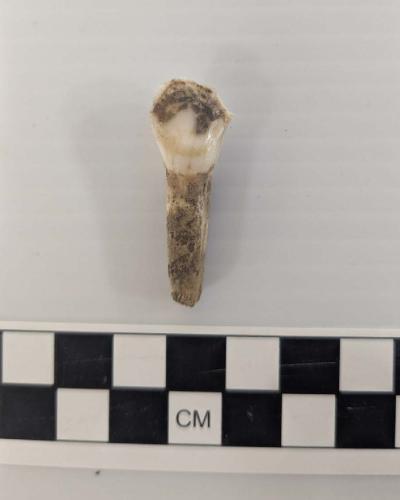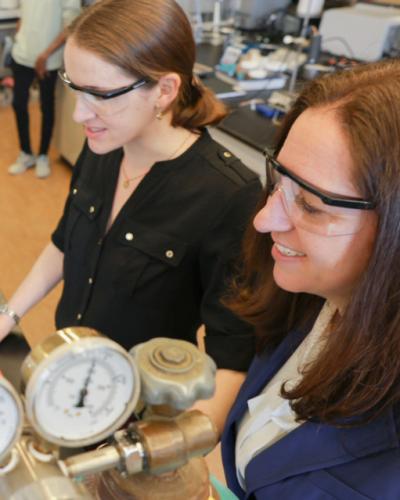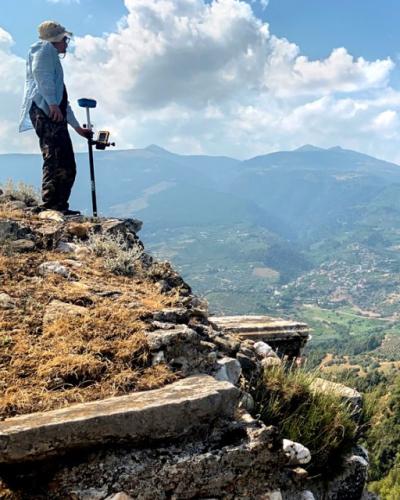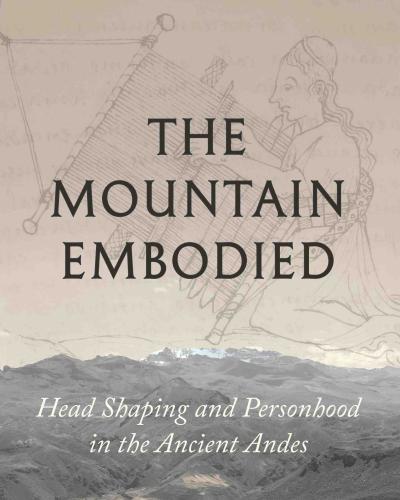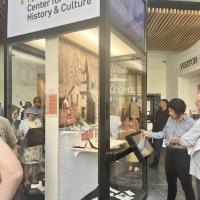“It’s a tooth!” We had been excavating a newly opened unit in the backyard of St. James AME Methodist church when my classmate made the discovery. We were excavating at the yard as part of a community partnership between Cornell’s archaeology department and the church. St. James had been an important stop along the Underground Railroad in the 1800s, and has been an important center of the African American community in Ithaca. The coal, glass, building materials, and ceramics that had been coming out of the units so far were important for understanding the daily life at the church, but I was at Cornell to study zooarchaeology, and that meant that this was the most exciting thing we had found that day. Later, when we were gently cleaning the artifacts in the lab the molar was passed around for all of us to look at. When it was my turn to hold it, I noted the lumpy enamel peaks that gave away its identity as pig and I wondered, “What can this tooth tell us about life at St. James?”
Zooarchaeology is the study of faunal (animal) remains in archaeological contexts. In the present as well as the past, human and animal lives are often entwined in life and death. At many archaeology sites, such as at St. James, faunal remains such as bones, teeth, shells, and rarely hides, are found. In the mid 20’th century, the discipline of zooarchaeology began to be developed to study these faunal remains. The first researchers came from zoology and paleontology backgrounds. They pioneered methods in identifying different animal bones. Collaboration between scientists, archaeologists, and veterinarians were important in creating the reference collections and literature that built the foundations for modern zooarchaeology. As the discipline grew, zooarchaeologists have been able to make important contributions to studies on past agriculture, animal domestication, foodways, and many other topics. Today, many zooarchaeologists also study the symbolic and social roles that defined many human-animal relationships in the past.[i]
Zooarchaeology draws from many different methods to analyze faunal remains. Bone identification requires lots of training in being able to notice the subtle differences between different species’ bones, and in knowing which part and side of the body bone fragments came from. Sex and age of the animal can sometimes be determined by looking for specific traits in the bones. Disease and injury may also leave their marks on bones. Zooarchaeologists can do DNA analysis on faunal remains to learn about an animal’s genetics. Another technique, Stable isotope analysis, uses mass spectrometry to measure traces of isotopes such as carbon, oxygen, and nitrogen in teeth and bones. This information can tell us about the plants animals consumed and the environment that they lived in.
One of the ways that zooarchaeology commonly contributes to our understanding of past people is through what it tells us about what and how they ate. Often, the faunal remains found at sites represent what was left behind after butchery and meals, and by studying them we can learn more about the foodways of the population. Our pig molar, shown in Figure 1, suggests that at some point in St. James’s past there may have been a whole pig carcass on site that was butchered for a meal(s). The pig may or may not have been slaughtered at the church, but some degree of meat processing was probably happening there.
Figure 1. Pig molar, St. James 2023.
2021 was the first year for the St. James excavations, and many animal bones were discovered, along with various aquatic shells and eggshells. In 2022 many more bones were discovered. These bones were cleaned and are in the process of being added to the catalog of artifacts found at Saint James. In addition to this general catalog, I will be making another one specifically for the faunal bones that will record the details that I will learn during my analysis of the bones. I will modify Cornell zooarchaeologist Doctor Nerissa Russel’s codebook for faunal elements to be more applicable for a North American faunal population, and will then use these codes to input data in the faunal catalog.
Unfortunately, I won’t be able to analyze the faunal bones that are being found this season. They are still being discovered and cleaned, and there are enough bones waiting to be looked at from the previous years that I expect to examine. This means that the pig tooth we found in the field won’t get analyzed past our initial identification for a little while. Instead, let us think about how to apply zooarchaeological analysis using this bone from 2022, shown in Figure 2:
Figure 2. Cattle astragalus, St. James 2022.
This is an astragalus, also known as the talus bone (especially for humans). If you touch the top of your foot where it meets your leg, you might be able to feel this bone. Based on the shape and size of it, I am able to determine that it belonged to some kind of cattle. In cattle, the astragalus, along with the other tarsals (the bones that make up your foot other than your toes), are located at what you might think looks like their knee but is actually their ankle. Bones look different depending on whether they are on the left or right side of the body, and I was able to identify this one as having belonged to the right foot of this animal. If it was a left astragalus it would look like an inverse version of what you see in this picture. This siding information would become important if we were to find another astragalus on site. If we discover another right astragalus, we would know that we are dealing with two separate individual animals. Zooarchaeologists use MNI (minimum number of individuals) to talk about the smallest possible number of animals at a site. In our example, If we had two right astragali we would have an cattle MNI of 2, but if we had one left and one right our MNI would be 1. Since we currently only have one astragalus, our MNI is 1.
I did not see any cut marks on the astragalus, possibly because it is located on a part of the cow that doesn’t contain much meat, but this is another way that zooarchaeologists can learn more about butchery methods and the types of food eaten in the past. Under a microscope, archaeologists can even notice details in the cut marks that can tell us what kind of tool might have been used, for example whether it was a stone or metal tool. Archaeologists need to be careful when looking at marks on bones to not confuse butchery marks with marks that happened at a different time. For example, sometimes during excavation a bone might get hit with an archaeologist’s trowel by accident. Luckily for us, the newer marks appear as a lighter color compared to the rest of the bone, whereas original marks are the same color. This bone did have some scrape marks, but since they were a different color I think that they were more recently added.
Figure 3. Cow incisor, St. James 2022.
In figure 3 we have another kind of tooth. Notice how different it looks from the pig tooth we looked at earlier? The size, shape, and glassy surface texture tell us that it is a cattle incisor, and that it came from the bottom right of the front part of the mouth. The astragalus bone could only tell us that there had been a cattle leg at the site, and it could have come from a carcass that had been butchered elsewhere; perhaps a beef leg was bought at the market. This tooth, for the reasons discussed with the pig tooth, suggests that the whole animal was present at the church, and more intensive butchery would probably have taken place to prepare it. This still leaves us with much that we don’t know about the events surrounding the deposition of these elements. We assume that these animals were eaten since they are species often raised for meat and are unlikely to have ended up in this urban environment if they were not tied to consumption, but we don’t know who was eating them. Were they private meals from the parsonage next to the church, or were they eaten by church members, perhaps at a barbeque or celebration?
From these examples I have tried to show how zooarchaeologists are able to use their knowledge about animal bones to learn more about the lives of the people who interacted with the animals whose remains we have. Over the course of the semester, I will be applying what I am learning about faunal identification and analysis to study the rest of the bones from 2021 and 2022. While not all of the faunal remains are as diagnostic as the ones I looked at above, I hope to be able to better develop our understanding of the meat use at St James. While I am sure there will be room to build upon my analysis in the future with the bones themselves, there are also other related topics that we can hope get explored. Archival research might be able to provide more context for use of animals at St. James, and possibly information about how food waste was disposed of at the time. I will not be looking at the many aquatic shells that have been discovered, but someone with more knowledge about mollusks may be able to identify the species and other relevant information. Some egg shells have also been excavated, and by weighing them it might be possible to identify species.[ii] Stable isotope analysis could also tell us information about what foods livestock were being fed.
I think that zooarchaeology is an interesting and important subfield that has much to contribute to our understanding of past people. At St. James, faunal analysis can provide insights into the eating habits of the parishioners there. Food is much more than simple nutrition, and it is an integral part of how we experience our lives. When meals are shared, such as what might have been happening at the church, relationships are formed and community is sustained. Even solitary meals can require interactions at the market, or with farmers. Social, racial, and economic contexts can also affect what kinds of food are available to eat. Understanding this past is important for scholars, but even more so for the local and descendant communities who are connected to St. James. Much of what we can hope to learn about St. James is outside the scope of what I expect to be able to learn from my faunal analysis this semester, but I hope that my work can be built upon by future researchers.
[i] Gifford-Gonzalez, Diane. An Introduction to Zooarchaeology. Springer International Publishing, 2018.
[ii] Nerissa Russell, Personal Correspondence.



